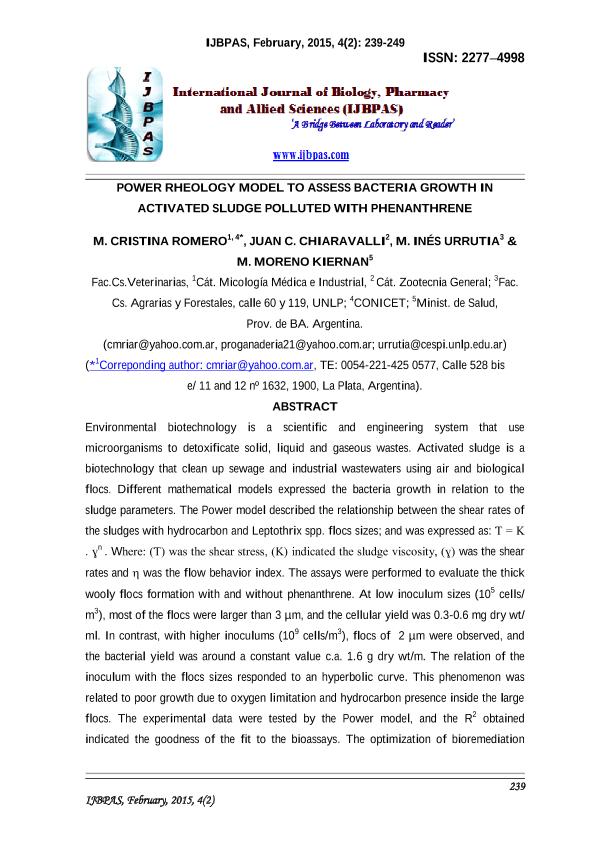Mostrar el registro sencillo del ítem
dc.contributor.author
Romero, Maria Cristina

dc.contributor.author
Chiaravalli, Juan C.
dc.contributor.author
Urrutia, María Inés

dc.contributor.author
Moreno Kiernan, Alejandro Ricardo

dc.date.available
2018-08-02T22:20:44Z
dc.date.issued
2015-10
dc.identifier.citation
Romero, Maria Cristina; Chiaravalli, Juan C.; Urrutia, María Inés; Moreno Kiernan, Alejandro Ricardo; Power rheology model tto assess bacteria growth in activated sludge polluted with phenanthrene; International Journal of Biology, Pharmacy and Allied Sciences; International Journal of Biology, Pharmacy and Allied Sciences; 4; 2; 10-2015; 239-249
dc.identifier.issn
2277-4998
dc.identifier.uri
http://hdl.handle.net/11336/54019
dc.description.abstract
Environmental biotechnology is a scientific and engineering system that use microorganisms to detoxificate solid, liquid and gaseous wastes. Activated sludge is a biotechnology that clean up sewage and industrial wastewaters using air and biological flocs. Different mathematical models expressed the bacteria growth in relation to the sludge parameters. The Power model described the relationship between the shear rates of the sludges with hydrocarbon and Leptothrix spp. flocs sizes; and was expressed as: Ƭ = K . ɣ n. Where: (Ƭ) was the shear stress, (K) indicated the sludge viscosity, (ɣ) was the shear rates and was the flow behavior index. The assays were performed to evaluate the thick wooly flocs formation with and without phenanthrene. At low inoculum sizes (105 cells/m3), most of the flocs were larger than 3 µm, and the cellular yield was 0.3-0.6 mg dry wt/ml. In contrast, with higher inoculums (109 cells/m3), flocs of 2 µm were observed, and the bacterial yield was around a constant value c.a. 1.6 g dry wt/m. The relation of the inoculum with the flocs sizes responded to an hyperbolic curve. This phenomenon was related to poor growth due to oxygen limitation and hydrocarbon presence inside the large flocs. The experimental data were tested by the Power model, and the R2 obtained indicated the goodness of the fit to the bioassays. The optimization of bioremediation strategies like the bacterial bioaugmentation in activated sludge, confirmed that the Power model provided the best prediction of viscosity that determined the aeration with the suspended solids and phenanthrene present in the sludges.
dc.format
application/pdf
dc.language.iso
eng
dc.publisher
International Journal of Biology, Pharmacy and Allied Sciences
dc.rights
info:eu-repo/semantics/openAccess
dc.rights.uri
https://creativecommons.org/licenses/by-nc-sa/2.5/ar/
dc.subject
Activated Sludge
dc.subject
Flocs
dc.subject
Leptothrix Spp.
dc.subject
Phenanthrene
dc.subject
Power Law
dc.subject
Viscosity
dc.subject.classification
Otras Ciencias Biológicas

dc.subject.classification
Ciencias Biológicas

dc.subject.classification
CIENCIAS NATURALES Y EXACTAS

dc.title
Power rheology model tto assess bacteria growth in activated sludge polluted with phenanthrene
dc.type
info:eu-repo/semantics/article
dc.type
info:ar-repo/semantics/artículo
dc.type
info:eu-repo/semantics/publishedVersion
dc.date.updated
2018-08-02T15:32:50Z
dc.journal.volume
4
dc.journal.number
2
dc.journal.pagination
239-249
dc.journal.pais
Reino Unido

dc.journal.ciudad
Londres
dc.description.fil
Fil: Romero, Maria Cristina. Consejo Nacional de Investigaciones Científicas y Técnicas. Centro Científico Tecnológico Conicet - La Plata; Argentina. Universidad Nacional de La Plata. Facultad de Ciencias Veterinarias; Argentina
dc.description.fil
Fil: Chiaravalli, Juan C.. Universidad Nacional de La Plata. Facultad de Ciencias Veterinarias; Argentina
dc.description.fil
Fil: Urrutia, María Inés. Universidad Nacional de La Plata. Facultad de Ciencias Agrarias y Forestales; Argentina
dc.description.fil
Fil: Moreno Kiernan, Alejandro Ricardo. Provincia de Buenos Aires. Ministerio de Salud; Argentina
dc.journal.title
International Journal of Biology, Pharmacy and Allied Sciences
dc.relation.alternativeid
info:eu-repo/semantics/altIdentifier/url/http://ijbpas.com/pdf/1422781614MS%20IJBPAS%202014%202115.pdf
dc.relation.alternativeid
info:eu-repo/semantics/altIdentifier/url/http://ijbpas.com/archive/archive_detail_pdf/Volume-4-Issue-2
Archivos asociados
